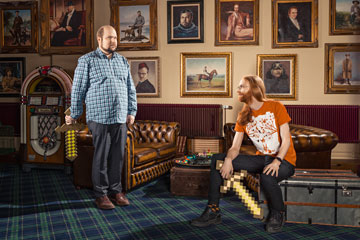
Persson, far left, and Bergensten, the minds behind Minecraft, brandishing the game's pixelated swords
(2 of 6)
Mojang--its name is the swedish word for gadget--didn't set out to create a phenomenon or a big business. But Minecraft is both. It is an indie smash in a video-gaming era dominated by blockbusters, sequels to blockbusters and would-be blockbusters bankrolled by giant corporations such as Activision Blizzard and EA. Mojang grossed almost $240 million in 2012, nearly all from sales of Minecraft, whose PC version sells for $26.95. Other editions are available for Xbox 360, iPhone, iPad and Android. In total, about 25 million copies have been sold.
All that's happened without any funding from outside investors or much of a marketing plan beyond cultivating a community on Twitter, Tumblr, Reddit and other online hangouts. Still tiny and independent, Mojang is headquartered in Stockholm's Sodermalm district, far from the industry's giants, in an area thick with trendy restaurants, quaint shops and small companies. (The area has gentrified considerably since it served as the setting for much of Stieg Larsson's The Girl With the Dragon Tattoo and its sequels.)
Four years ago, Mojang didn't exist, and Minecraft was a personal project by game developer Markus Persson, whose personal site says, "You can call me 'Notch.'" (Most Minecraft fans do, and so will I.) Notch, who would become Mojang's co-founder, public face and resident visionary, created Minecraft for one simple reason: he wanted it to exist. "I designed the game for myself--that's an audience I know," he told me recently, when we met in an intentionally gauche, James Bond-inspired Mojang conference room decked out entirely in gold materials.
Bearded, cherubic and self-effacing, Notch looks like a gamer, though not necessarily the leader of gamers he has become. Like most programmers, he began young, writing an adventure game for his father's computer at the age of 8. Now 33, Notch cheerfully admits that he didn't summon the concept that became Minecraft out of thin air. He says he drew crucial inspiration from Dwarf Fortress, a famously innovative, idiosyncratic and opaque fantasy simulation released in 2006. (Tech site Ars Technica called it "the most inscrutable video game of all time.") An even more direct ancestor is Infiniminer, a 2009 game that was much like Minecraft--except for the fact that its inventor lost interest in it almost as soon as it was finished. Unlike Infiniminer's creator, Notch kept plugging away. At first he worked on the game in spare moments while continuing in his job at a Stockholm company that made photo-album software. But long before the game was finished, he found that people were willing to pay for it. "The idea was to be self-sustaining," he says. "I started charging for the game a couple of weeks in."
A little over a year into the effort, he went full time. By early 2011, Minecraft the project had turned into Mojang the company, complete with a real office and actual co-workers. Along the way, Notch was quietly courting the growing community of Minecraft fanatics. He released experimental versions, blogged about his game-design decisions as he made them and uploaded teaser videos to YouTube. He also let players mold the game in ways he had never envisioned, using customization programs known as mods to add everything from volcanoes to zeppelins to their Minecraft worlds.
